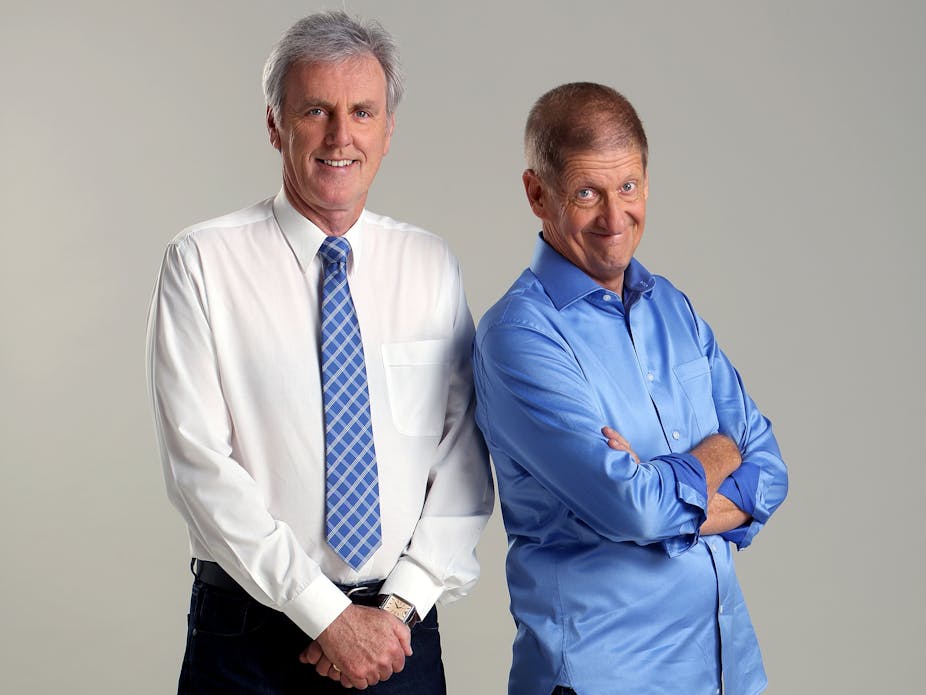The Sochi Winter Olympics has seen the return to Australian television screens of sport parodists extraordinaire “Rampaging” Roy Slaven and HG Nelson. Roy and HG’s Russian Revolution presents the familiar routines honed since the 1980s on radio and television, and which reached Olympian heights at the Sydney 2000 Games and The Dream with Roy and HG.
At the Sydney Olympics they wittily skewered the pretentiousness, national chauvinism and commercialism that mar this most global of sport spectacles. They even managed to cause consternation among the International and Australian Olympic Committees and their commercial sponsors by creating an absurd local fauna mascot, Fatso the Fat-Arsed Wombat, to rival the official trio of Millie (echidna), Olly (kookaburra), and Syd (platypus), the last of which they preferred to call Dickhead.
An unlikely symbol of spontaneous popular Olympic resistance to bureaucratic and commercial authority, Fatso made guerrilla on-camera appearances, including at some medal ceremonies with successful Australian athletes.
Fatso embodied Roy and HG’s comic technique of playing with the visual grammar and language of sport, rendering super-slow motion replays of live action in absurdist ways, and attaching curious folk labels, such as the “battered sav” and “Chiko roll”, to arcane gymnastic manoeuvres.
In alternative live calls of games such as rugby league’s State of Origin during their self-inaugurated Festival of the Boot, Roy and HG also invent nicknames for players, the most renowned of which is “The Brick with Eyes” for the now-federal Senator-elect Glenn Lazarus.
Repetition and circulation of nicknames for players (like “Backdoor Benny”) and for some of their practices (such as the “squirrel grip” to describe the practice of manhandling the genitals of opponents) provide an alternative framing of sport, substituting whimsy and wild extrapolation for the deadly earnestness of sports commentary.
And when stuck for a gag, Roy and HG can always resort to making fun of neighbouring New Zealand.
The vehicles for the performance of these feats are the stock characters that they inhabit. Roy is the know-it-all ex-sportsman prone to mythologise and re-invent his heroic past. HG is the combustible commentator always on the point of exploding into another barely comprehensible rant.
These archetypes are recognisable to anyone even mildly acquainted with the Australian sports media. But they also raise the question of whether Roy and HG’s humour only really works for the initiated: the people who understand and embrace the sport that is being parodied for comic effect.
And yet, to laugh at and with Roy and HG it is not necessary to know or to love sport, although sometimes it helps.
Roy and HG’s sport-related comedy works in two main ways and plays to rather different galleries. In their coverage of the most popular sports, they are making the familiar strange and exposing its inherent silliness. When covering the football codes or prominent Olympic sports like athletics, they are working with a substantial level of audience knowledge in a specialist, media-saturated environment.
Here Roy and HG’s shtick is to work with what is already well-known. They play around with the boilerplate clichés of sport coverage, stretching them to ridiculous degrees and exposing their banality and pomposity. This is familiarity breeding wry reflection rather than contempt.

By contrast, regarding minority summer Olympic sports like Greco-Roman wrestling or curling or Nordic combined in the Winter Olympics, most of the audience will know very little of the intricacies of the sports appearing on their screen, nor of the conventional ways in which they are described and analysed by commentators.
This lack of audience familiarity presents new comedic possibilities of making the already strange even stranger. It may eventually strike the viewer that both their beloved sports and the ones that they only encounter every four years have in common the bizarre artificiality of rule-governed competitive physical play.
Of course, audiences cannot be so easily quarantined. Those who know nothing and care less about sport may be amused by Roy and HG making sport with the obsessiveness of the diehard sport fan and their media servants.
Roy and HG simultaneously celebrate and critique the place of sport in Australian culture, as is encapsulated in their double-edged motto “Too much sport is barely enough”. They are clearly sport fans, and must walk a difficult line in which they do not turn into self-parodies, becoming too close to the people and behaviour that they are teasing or mocking.
But perhaps that is the secret of Roy and HG’s comedy: that in highlighting the foibles of others, they unerringly return the gaze to our own. Theirs is a rare insider auto-critique among sports presenters and commentators. They also offer a connection between the sport lover and the sport-phobic alike.
In the end, Roy and HG are funny because comedy runs, largely unacknowledged, through every sphere of human life. And none more so than in the oh-so-serious world of sport.

